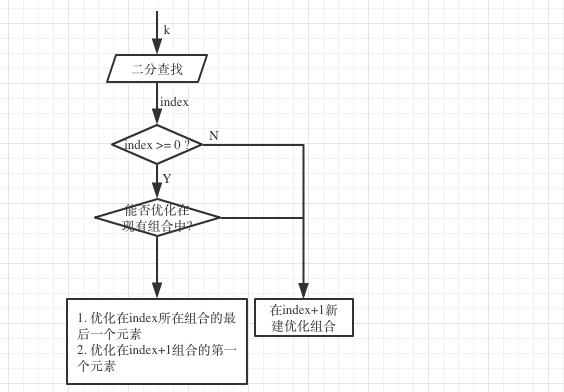Paper原文地址:An Experimental Study of Bitmap Compression vs.
Inverted List Compression
Bitmap可以说是一个很万能的存储了,无论是空间消耗,还是查询响应,在最佳实践下,都可以达到很好的效果。最近做了不少Bitmap的研究,简单的基于上面的Paper去做一个记录。
History
从最原始的Bitmap到RoaringBitmap(可能是目前大多数场景的最佳选择?),虽然仔细研究Roaring的原理并不复杂,但也是经过了十几年的变化和迭代。
WAH(Word Aligned Hybrid)
这个算法只压缩全0或者全1的group。将所有bits按照连续的31bit进行分组,然后对每一组进行编码,编码后的长度为32bit。具体结构如下图所示:
EWAH(Enhanced Word Aligned Hybrid)
基于WAH加了一个Header,作为元信息的存储。我理解这其实并没有在存储上做到太多帮助的优化,反而是在查询或者插入中,会更加便捷。Header结构如下所示。
CONCISE(Compressed N Composble Integer Set)
这也是基于WAH做的一个优化。在WAH算法中,只要有一个bit被置1,那么整个group都无法被压缩,这一算法在这种odd bit上做了优化。记录了这个单一odd bit的位置。
VALWAH(Variable-Aligned Length WAH)
基于参数的优化,缓解了WAH的每个group固定32bit的限制(因为32bit最多能表示2^31 - 1个压缩group,但是实际上不会那么多)。采用了参数去调控,没有固定的规则,对于不同的bitmap自动采用不同的参数,很影响查询的效率。
Roaring
以65535bit分bucket,每个bucket里的integer共享高16bit(为bucket的编号),例如第一个bucket为[0 ~ 65535],高16bit为0,第二个bucket为[65536 ~ 65536*2 - 1],高16bit为1。其中,65536中以short integer(16bit)为单位表示integer的低16bit。所以当这个bucket中integer 个数 > 4096时,不存在压缩。
RoaringBitmap源码解读
RoaringBitmap的基本构成如下:HighLowContainer中存储了每个Integer的高16bit的公共索引keys以及具体存储数字的Container。由于Container是最终的载体,所以优化基本都在Container里。下面直接分析源码中的Add方法,通过这个方法基本上可以看出Container的内部结构。
先看一个代码里比较常出现的binarySearch方法,这里比较灵活的一点是,如果找到则返回对应的index,如果没找到则返回对应位置的负数,这样既可以传递位置信息,又可以传递是否存在的信息。
protected static int hybridUnsignedBinarySearch(final short[] array, final int begin,
final int end, final short k) {
int ikey = toIntUnsigned(k);
// next line accelerates the possibly common case where the value would
// be inserted at the end
if ((end > 0) && (toIntUnsigned(array[end - 1]) < ikey)) {
return -end - 1;
}
int low = begin;
int high = end - 1;
// 32 in the next line matches the size of a cache line
while (low + 32 <= high) {
final int middleIndex = (low + high) >>> 1;
final int middleValue = toIntUnsigned(array[middleIndex]);
if (middleValue < ikey) {
low = middleIndex + 1;
} else if (middleValue > ikey) {
high = middleIndex - 1;
} else {
return middleIndex;
}
}
// we finish the job with a sequential search
int x = low;
for (; x <= high; ++x) {
final int val = toIntUnsigned(array[x]);
if (val >= ikey) {
if (val == ikey) {
return x;
}
break;
}
}
return -(x + 1);
}
ArrayContainer
short[] content;
@Override
public Container add(final short x) {
int loc = Util.unsignedBinarySearch(content, 0, cardinality, x);
if (loc < 0) {
// Transform the ArrayContainer to a BitmapContainer
// when cardinality = DEFAULT_MAX_SIZE
if (cardinality >= DEFAULT_MAX_SIZE) {
BitmapContainer a = this.toBitmapContainer();
a.add(x);
return a;
}
if (cardinality >= this.content.length) {
increaseCapacity();
}
// insertion : shift the elements > x by one position to
// the right
// and put x in it's appropriate place
System.arraycopy(content, -loc - 1, content, -loc, cardinality + loc + 1);
content[-loc - 1] = x;
++cardinality;
}
return this;
}
相关变量说明:
- content: 为了增删改查的方便性,采用short有序数组来存储数字(注意高16bit已经存储在HighLowContainer中,所以这里只需要存储低16bit的short就满足了)。
- DEFAULT_MAX_SIZE: 由于有序数组在插入时需要做二分查找,效率较低,所以这里有一个限定4096,超过这个大小自动转成BitmapContainer。
add流程如下:
- 通过二分查找找到x所在的content中的位置,若存在则不处理,不存在则进入下一步。
- 对cardinality进行判断,决定是否需要升级Container或者扩容。
- 将content中loc之后的子数组后移一位,将数据插入,形成新的content数组。
BitmapContainer
final long[] bitmap;
@Override
public Container add(final short i) {
final int x = Util.toIntUnsigned(i);
final long previous = bitmap[x / 64];
long newval = previous | (1L << x);
bitmap[x / 64] = newval;
if (USE_BRANCHLESS) {
cardinality += (previous ^ newval) >>> x;
} else if (previous != newval) {
++cardinality;
}
return this;
}
相关变量说明:
- bitmap: 1个Container中可以存储65536(2^16bit)个数字Integer,在BitmapContainer中再以long(2^6bit)做分组,形成了long数组。
add流程如下:
- 通过x/64找到bitmap中的long数组中的位置得到原值previous。
- previous | (1L << x) 得到newval。
- 改变cardinality。
可以发现当Integer分布稠密时,容易在一个long中出现连续1的情况,在这种情况下也存在优化空间,可以调用runOptimize升级为RunContainer。
RunContainer
主要解决了连续1的情况,例如15、16、17、18可以被优化成15,3。RunContainer中的关键变量为valuesLength,类型是short[]。其中,2n位是具体数值,2n+1为2n往后的连续个数。
例如:valuesLength = [1,3,15,2,88,4]表达的RoaringBitmap为1,2,3,15,16,88,89,90,91。
private short[] valueslength;
int nbrruns = 0;
add方法如下所示:
@Override
public Container add(short k) {
// TODO: it might be better and simpler to do return
// toBitmapOrArrayContainer(getCardinality()).add(k)
// but note that some unit tests use this method to build up test runcontainers without calling
// runOptimize
int index = unsignedInterleavedBinarySearch(valueslength, 0, nbrruns, k);
if (index >= 0) {
return this;// already there
}
index = -index - 2;// points to preceding value, possibly -1
if (index >= 0) {// possible match
int offset = toIntUnsigned(k) - toIntUnsigned(getValue(index));
int le = toIntUnsigned(getLength(index));
if (offset <= le) {
return this;
}
if (offset == le + 1) {
// we may need to fuse
if (index + 1 < nbrruns) {
if (toIntUnsigned(getValue(index + 1)) == toIntUnsigned(k) + 1) {
// indeed fusion is needed
setLength(index,
(short) (getValue(index + 1) + getLength(index + 1) - getValue(index)));
recoverRoomAtIndex(index + 1);
return this;
}
}
incrementLength(index);
return this;
}
if (index + 1 < nbrruns) {
// we may need to fuse
if (toIntUnsigned(getValue(index + 1)) == toIntUnsigned(k) + 1) {
// indeed fusion is needed
setValue(index + 1, k);
setLength(index + 1, (short) (getLength(index + 1) + 1));
return this;
}
}
}
if (index == -1) {
// we may need to extend the first run
if (0 < nbrruns) {
if (getValue(0) == k + 1) {
incrementLength(0);
decrementValue(0);
return this;
}
}
}
makeRoomAtIndex(index + 1);
setValue(index + 1, k);
setLength(index + 1, (short) 0);
return this;
}
这里的决策方法略为复杂,用流程图来表示应该会比较直观。
Container之间比较如下:
| Container | 空间利用率 | 查询效率 |
|---|---|---|
| ArrayContainer | 无压缩、低 | 使用二分查找,低 |
| BitmapContainer | 无压缩、低 | 直接利用索引命中,高 |
| RunContainer | 有压缩、高 | 顺序查找,中 |